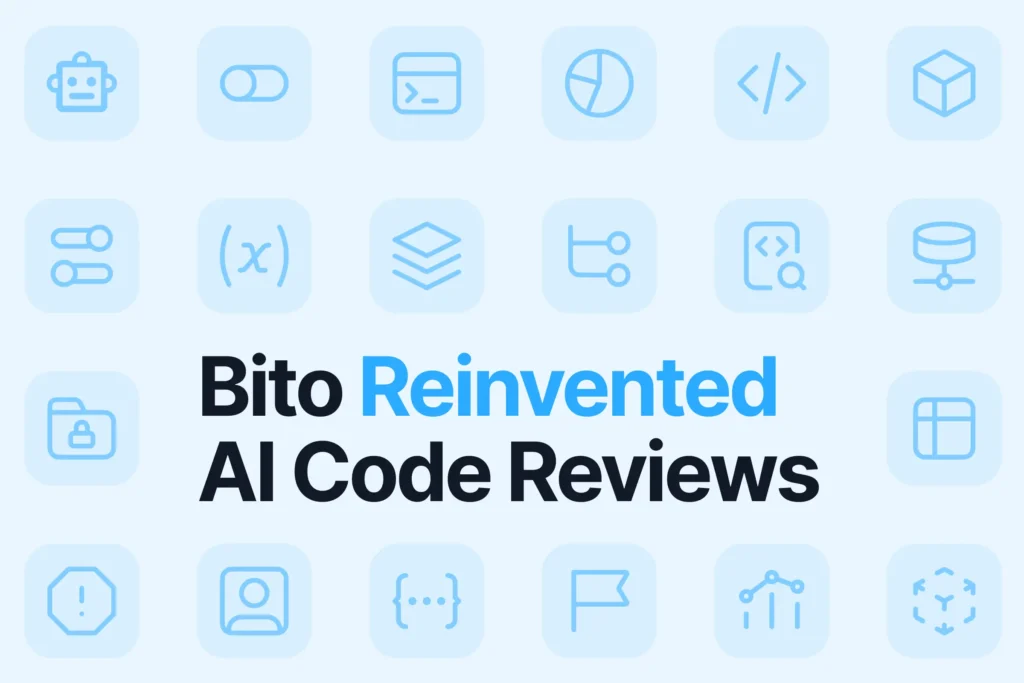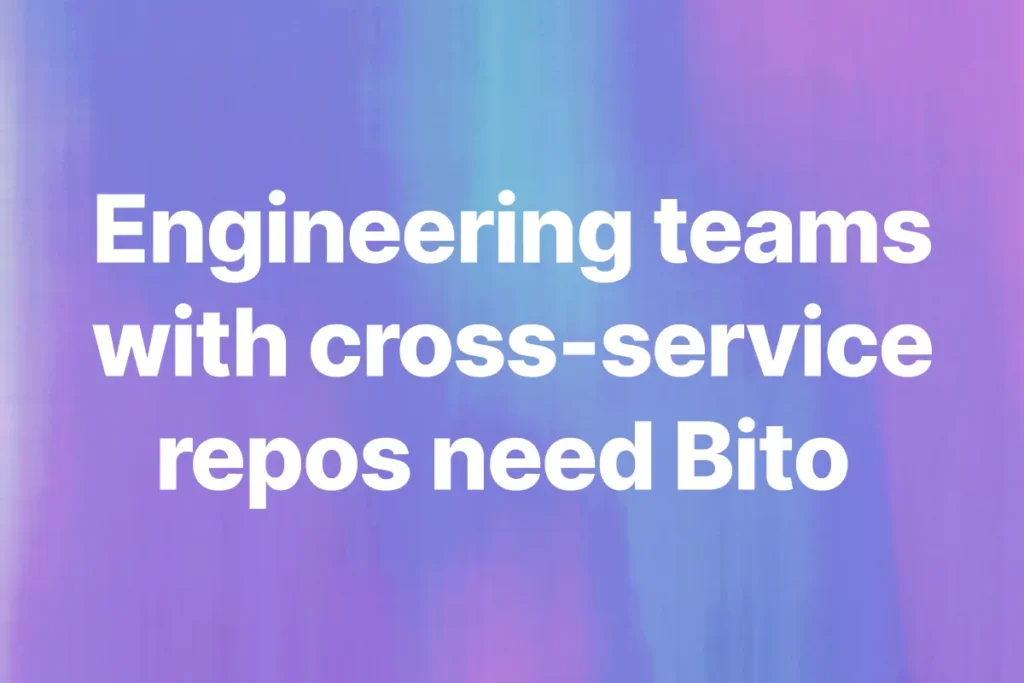If you’ve been searching for Cursor alternatives, you’re probably already familiar with the pitch.
Cursor is an AI-first code editor designed to enhance developer productivity through seamless pair programming, fast code suggestions, and chat-style assistance within your IDE.
It’s clean, fast, and impressive for what it does. But the catch is: Not everyone wants to switch their editor just to get decent AI support. And not every team is ready to rebuild their workflow around one tightly integrated tool.
That’s where alternative AI coding assistants come into play, offering diverse features to suit different development needs.
In this post, I’ll walk you through some of the best AI coding assistants available right now. Tools that improve your workflow without asking you to change how you work. Some are lightweight companions, some are full-stack assistants, and a few might quietly replace three extensions you’re already using.
1. Bito
Bito is an advanced AI-powered development assistant that goes beyond simple code suggestions. It integrates AI Code Review, an AI Coding Agent, and AI Chat to automate pull request reviews, execute coding tasks, and provide intelligent development assistance — all within VS Code.
Products and features:
- AI Code Review Agent: Automates pull request analysis, provides structured feedback, detects security risks, and reduces manual review time.
- Bito Wingman (AI Coding Agent): Reads Jira tickets, updates code, commits changes, and integrates with GitHub, GitLab, and Confluence to manage entire development workflows.
- AI Chat & AI that understands your code: Provides real-time coding assistance, explains complex code, and suggests edits based on the user’s open files.
- AI Code Completion: Predicts and auto-completes code for faster development.
- Security and Static Analysis: Detects vulnerabilities and applies best practices automatically.
Bito vs Cursor
- Cursor is built as a full AI editor. You have to adopt their environment to get the full experience.
- Bito takes a different approach. It lives inside your existing IDE and works with your current tools.
- Cursor helps you write code faster, no doubt. Bito goes beyond that. It reviews your pull requests, updates code based on Jira tickets, and even commits those changes for you.
Why choose Bito?
Bito is one of the best Cursor alternatives out in my market. It is an AI assistant that actively works within your workflow to automate code reviews, execute development tasks, and optimize software quality. Unlike tools that only provide suggestions, Bito takes action, making development faster and more efficient.
2. TabNine

TabNine is an AI-powered autocomplete tool providing context-aware code suggestions to streamline the coding process. It works inside editors like VS Code, JetBrains IDEs, Atom, and Sublime Text.
TabNine’s focus is speed. As you write, it predicts the next word, line, or block based on your current context.
You do not need to prompt it or open a separate chat. TabNine works quietly in the background, suggesting code as you type.
Key features:
- Supports multiple programming languages, including Python, JavaScript, C++, and Rust.
- Deep editor integrations, compatible with most modern code editors.
- Free version available, with a Pro plan offering advanced AI models.
- Offline support for developers who prefer not to rely on cloud-based AI tools.
- Privacy-focused with no telemetry tracking user code.
TabNine vs Cursor
- Cursor is an AI-first editor. TabNine is an autocomplete engine that fits into the tools you already use.
- Cursor expects you to work inside its environment. TabNine works silently inside yours, offering suggestions without changing your setup.
- If you are looking for something that enhances speed and typing flow rather than changing how you build software, TabNine is a better fit.
Why choose TabNine
TabNine is ideal for developers who want fast, predictive coding without the overhead of switching tools or relying on cloud-based prompts. It keeps your workflow simple, your data private, and your typing fast.
3. Windsurf by Codeium

Windsurf is an AI-powered IDE developed by Codeium. It integrates AI agents and copilots to assist with coding, debugging, and workflow automation. Unlike standard code assistants, Windsurf is designed to actively collaborate with developers rather than just providing autocomplete suggestions.
Key features:
- Flows system enables AI to work alongside developers with real-time awareness.
- Cascade AI system offers multi-file editing, command execution, and deep contextual understanding.
- Built on VS Code but optimized for AI-driven development.
- Low-latency performance with enhanced indexing and search capabilities.
- Free access to Cascade credits, premium models, and additional Pro features on download.
Windsurf vs Cursor
- Cursor and Windsurf both aim to redefine how developers write and manage code with AI, positioning themselves as next-generation AI code editors. But they do it differently.
- Cursor wraps AI features inside a clean code editor. Windsurf builds an entire system around collaborative AI agents that understand workflows, not just code snippets.
- If you want a dev environment where the AI helps you navigate, refactor, and automate with deeper context, Windsurf brings more to the table.
Why choose Windsurf
Windsurf is for developers who want more than code suggestions. Its Flows and Cascade systems let you build and ship with AI that understands your entire project structure. It works inside VS Code but gives you tools that feel custom-built for AI-first development.
You can also read our detailed comparison – Cursor vs Windsurf: Features & Pricing Compared (2025)
4. GitHub Copilot

GitHub Copilot, powered by OpenAI Codex and other AI models, assists developers by generating entire functions, suggesting boilerplate code, and helping debug errors.
Key features:
- Supports multiple AI models, including GPT-4o, GPT-4.5, Claude 3.5 Sonnet, Claude 3.7 Sonnet, o1, o3-mini, and Google Gemini 2.0 Flash.
- Understands natural language prompts, allowing developers to describe code in plain English.
- Supports a wide range of programming languages.
- Continuously improves with training from public code repositories.
- Integrated directly into Visual Studio Code, JetBrains, and Neovim.
- Provides in-editor explanations for better understanding of code suggestions. ggestions.
GitHub Copilot vs Cursor
- Both Copilot and Cursor bring AI into the coding experience, but with different approaches. Cursor is a standalone AI editor. Copilot is an assistant that integrates directly into editors like VS Code, JetBrains, and Neovim.
- Copilot focuses on generating code with high accuracy, backed by powerful models and trained on vast public repos. Cursor adds AI-driven editing features, but Copilot is more focused on suggestions that keep you in flow inside tools you already use.
Why choose GitHub Copilot
Copilot works where you already code and supports natural language prompts, inline completions, and multi-model flexibility. If you’re looking for smart autocomplete, in-editor chat, and code explanation features without changing environments, Copilot gets the job done.
Want to see a comprehensive comparison between Bito and Github Copilot? Read our comparison page: Bito vs GitHub Copilot.
5. TabbyML

TabbyML is an open-source AI coding assistant designed for developers and teams who want full control over how AI integrates with their workflow. Unlike commercial tools that host models in the cloud, TabbyML lets you deploy and manage your own AI code completion server.
You can run it locally or in your own infrastructure, fine-tune it for your tech stack, and make it as secure and private as you need.
Key features:
- Self-hosted, allowing developers to deploy their own AI-powered coding assistant.
- Supports multiple programming languages.
- Open-source and community-driven.
- Allows fine-tuning of AI models for custom coding environments.
- Ensures complete control over data privacy and model security.
TabbyML vs Cursor
- Cursor is closed-source and tied to a hosted ecosystem. TabbyML is an open-source code editor that is fully self-hosted, offering flexibility and control over your development environment.
- Cursor gives you convenience. TabbyML gives you control. You decide where your code runs, how your models behave, and how AI integrates with your environment.
Why choose TabbyML
TabbyML is ideal for developers who care about full-stack ownership and flexibility. If you’re building internal tools, working with sensitive code, or just want AI that respects your rules, TabbyML gives you the infrastructure to run AI your way.
6. CodeGeeX

CodeGeeX is an AI-powered coding assistant built around a large-scale multilingual model. It supports more than 20 programming languages and is designed to help generate and complete code with better contextual understanding.
It runs smoothly across operating systems and cloud environments and provides both inline suggestions and an interactive prompt mode to refine outputs before inserting them into your code.
Key features:
- Supports AI-powered code completion and generation.
- Works across Mac, Windows, Linux, and cloud environments.
- Optimized for multiple programming languages.
- Uses a 13-billion parameter model for enhanced contextual predictions.
- Provides an interactive prompt mode for refining generated code snippets.
CodeGeeX vs Cursor
- Cursor focuses on building an AI-native editing experience. CodeGeeX brings the same generation capabilities to a broader environment without locking you into a specific editor.
- Cursor wraps AI around your editor. CodeGeeX gives you control through prompts and completions, all while staying flexible with where and how you use it.
Why choose CodeGeeX
CodeGeeX is built for developers who work across languages and want a fast, customizable generation tool that stays out of the way. It is especially useful for global teams or projects that span multiple environments and languages.
7. Intellicode

Intellicode is Microsoft’s AI-powered coding assistant that comes built into Visual Studio and VS Code. It extends IntelliSense by offering smarter, more contextual suggestions based on real-world code and your team’s own coding patterns.
Rather than just suggesting completions from a static model, Intellicode learns from your codebase to prioritize what is most relevant in your specific project.
Key features:
- Deep integration with Microsoft IDEs.
- Learns from your team’s codebase for more relevant suggestions.
- Supports multiple languages.
- Suggests the most relevant code snippets based on real-world coding patterns.
- Allows team-wide AI training to enhance collaboration.
Intellicode vs Cursor
- As I’ve already mentioned in almost every section, Cursor delivers AI features through a standalone editor. Intellicode enhances the tools many developers already use, especially those working in Microsoft environments.
- Cursor emphasizes general-purpose code generation. Intellicode focuses on contextual assistance grounded in how your team actually writes code.
Why choose Intellicode
Intellicode is for developers who want AI assistance that adapts to their existing tools and team patterns. It makes suggestions more relevant by learning from how your team writes, not just how the internet codes. If you are already in the Microsoft ecosystem, Intellicode is the most seamless AI layer you can add.
8. Zed Editor

Zed Editor is a high-performance, open-source text editor built by the team behind Atom and Electron. It focuses on speed, simplicity, and real-time collaboration without the overhead of full IDEs or proprietary systems.
Zed keeps things lean. It is designed for developers who want minimal UI, fast startup, and just enough tooling to stay productive without distractions., Zed is fully open-source.
Key features:
- Real-time collaboration for pair programming.
- Built-in Vim mode, syntax highlighting, and lightweight design.
- Free and open-source.
- High-performance architecture optimized for low-latency editing.
- Designed for developers who prefer a distraction-free interface.
Zed Editor vs Cursor
- Cursor offers a full AI development experience with editing, chat, and terminal built in. Zed focuses on being a fast and open text editor, enhancing developer productivity without unnecessary distractions.
- If you care more about low-latency performance, open-source code, and collaborative editing, Zed is a better match.
Why choose Zed Editor
Zed is perfect for developers who want performance and simplicity over heavy feature sets. If you value open-source tools and prefer a lightweight environment that does one thing well, Zed delivers.
9. Void

Void is an open-source AI code editor built as a fork of VS Code. It offers the familiar experience of your current editor, but with full AI integration, support for any large language model, and complete control over how your data is handled.
It feels like Cursor, but without the lock-in. You can use any LLM, stay local if you want to, and migrate your existing settings in one click.
Key features
- Built on VS Code with one-click transfer of themes, keybinds, and settings
- Works with any LLM, including local models like Llama, DeepSeek, and Qwen
- No private backend, everything runs directly through your chosen model provider
- Features like autocomplete, inline edits, and multi-mode chat (normal, agent, gather)
- Agent Mode supports search, file creation, editing, and terminal access
- Weekly community meetups, open contributions, and fast development cycles
Void vs Cursor
- Cursor gives you a polished, opinionated experience that depends on its own backend and default AI stack. Void offers a customizable AI coding assistant experience, allowing you to choose the model, provider, and execution of AI features.I features run.
- If you want AI tooling without giving up control, Void is the closest open-source alternative to Cursor that still feels familiar.
Why choose Void
Void is for developers who want the power of AI without the limits of closed systems. Whether you are using hosted LLMs or running them locally, Void lets you bring your own models, plug them in, and work the way you want.
Conclusion
Choosing the right Cursor alternative depends on your development needs. If you’re looking for basic autocomplete, TabNine and Codeium offer strong AI-driven suggestions. GitHub Copilot provides deeper code generation, while TabbyML gives you a self-hosted option. Open-source tools like Zed Editor and Codeium offer flexibility for customization.
For developers who need more than just suggestions, Bito delivers a complete AI-powered development experience. With AI Code Review for automated PR feedback, Bito Wingman for task execution, and AI Chat for real-time coding assistance, it actively integrates into your workflow to streamline development.
👉 Looking for an AI assistant that does more? Try Bito and see the difference.
FAQs (Frequently Asked Questions)
What can I use instead of Cursor?
The most common swaps are GitHub Copilot, Windsurf, Replit AI, TabNine, and the JetBrains AI Assistant, all of which plug into major editors and give AI help while you code.
What is the best Cursor alternative?
For fast auto completion tied to GitHub, many go with Copilot, while developers who want a free open source stack lean toward Codeium. But in my personal opinion, the best cursor alternative for code generation is Windsurf.
Who competes with Cursor?
Direct rivals include GitHub Copilot, Windsurf, Amazon Q Developer, JetBrains AI Assistant, Codeium, Replit AI, and TabNine. Each wraps a large language model into your editor so you can write, refactor, or review code faster.
Is there a free version of Cursor?
Yes. Cursor offers a Hobby plan that costs nothing and gives roughly fifty fast AI requests plus unlimited auto completions every month.
Is Cursor AI better than ChatGPT?
Cursor lives inside your editor and reads your files, so it is often better for day to day coding tasks. ChatGPT is a general chatbot that works well for broad questions but cannot act directly on a live repo without extra steps. Many developers keep both in their toolkit.






